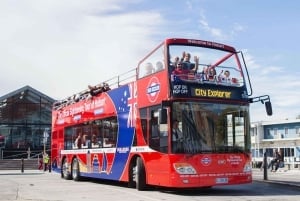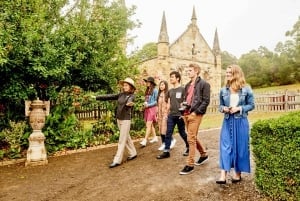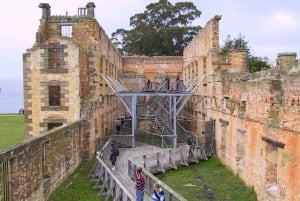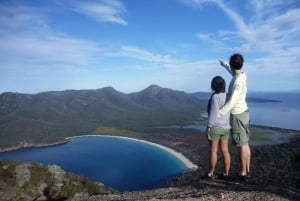Ten Great Short Walks in Tasmania
Adventure
Most visitors to the Tasman Peninsula come to see the famous ruins of Port Arthur...
Book Top Experiences and Tours in Tasmania:
If youʻre booking your trip to Tasmania last minute, we have you covered. Below are some of the top tours and experiences!
View All Experiences
Unspoilt but accessible, Tasmania’s nature is the perfect destination for bushwalking and other outdoor activities. Throughout the island state you can find over 2000 km of walking tracks – if you were to put them together in a straight line, they would cover the distance from Sydney to Cooktown.
Most hiking tracks run through Tasmania’s stunning 19 national parks and many of them are very well maintained and signposted. The tourist information centres provide information regarding weather and track conditions. Many national parks also offer guided tours with rangers who know a great deal about the flora and fauna, making these tours great family things to do in Tasmania.
If you’re feeling spoilt for choice, here are our top picks for short walks around Tasmania:
1. Mt Wellington/Organ Pipes, Hobart
It is hard to find a more scenic setting for a capital city than the mountain slopes and river banks that provide the stage for Hobart. To take in the vast extent of the city’s beauty, a trip up to the top of Mt Wellington is a must for every Hobart visitor. The views are even more rewarding if you make your way to the top under your own steam. There is a dense network of hiking tracks in Wellington Park, so you’re well advised to pick up a map from the visitor centre before you head off.
Metro buses 48 and 49 operate between Franklin Square and Fern Tree at the foot of Mt Wellington. Just down the road is a car park and picnic area, from which the Fern Glade Track ascends into the forest. Follow this track until you reach Woods Track and further up Betts Vale Track and Shoobridge Track, which will take you past the ancient Octopus Tree. Via Lower Sawmill Track and Sawmill Track you will reach the Organ Pipes Track. This path offers superb views over Hobart to one side and the dolerite columns called Organ Pipes to the other. After enjoying the splendid views, walk back along the Organ Pipes Track until you reach the Pinnacle Track, which will take you up to the top of Mt Wellington via the Zig Zag Track. The summit is about a 3-hour hike from Fern Tree. The Hobart shuttle bus will take you back to the city.

2. Cape Huay, Tasman Peninsula
Most visitors to the Tasman Peninsula come to see the famous ruins of
Port Arthur. But this stunning piece of land – only connected to Tasmania by a narrow land bridge – is also a hiker’s paradise. From the car park at the Fortescue Bay Camping Ground an easy 3 to 4-hours return hike takes you to the spectacular Cape Huay. From here you can enjoy dizzying views along Australia’s highest cliffs including the Totem Pole.
3. Cataract Gorge, Launceston
From the town centre in Launceston you can reach the beautiful Cataract Gorge on foot in only 10 – 15 minutes. Cross the bridge across the South Esk River and turn left following the track into the gorge. The scenery changes abruptly from a light and peaceful garden landscape to a scenery of dramatic steep cliffs and rough waters. Cross the bridge past the first basin and follow the track to the Cataract Gorge Reserve. On a hot day this is a great place for a swim and a picnic. A walking trail south of the river takes you through the hills back to Paterson Street.
4. Painted Cliffs, Maria Island
For day-trippers to Maria Island this is a great short walk taking in the major
attractions of this peaceful place. From the Darlington Jetty walk to the small settlement of Darlington, which gives you a glimpse of the island’s convict history. Follow the track along the coast past the campground and the grassland. Here you can often encounter Forester kangaroos, wallabies and Cape Barren geese. Turn off to the right and walk along Hopground Beach, which will take you to the bizarre rock formations of the Painted Cliffs. You can walk back to Darlington the same way (around 2 hours return) or turn right past Howell’s Cottage to return to Darlington inland.

5. Wineglass Bay/Hazards Beach Circuit, Freycinet National Park
When it comes to Wineglass Bay, the photos really don’t lie. The view across this picture-perfect combination of smooth ocean inlet, white beach and lush eucalypt forest will stun you on any reasonably good day. But it’s definitely worth discovering a bit more of the beautiful Freycinet National Park. For the Wineglass Bay/Hazards Beach Circuit follow the hordes of tourists from the Walking Tracks Car Park up to the Wineglass Bay Lookout (30-40 minutes). From here the track drops down to Wineglass Bay, where you can refresh yourself in the cool waters.
The Isthmus Track turns off just before you reach the beach, so head back to the junction and follow this track. It will take you inland right through to the west coast of the peninsula. After around 30 minutes you will reach Hazards Beach, which you can walk along northwards across some rough rocky sections. The full circuit back to the car park will take around five hours to complete.
6. Alum Cliffs
If you are visiting the area around Mole Creek, don’t miss the impressive Alum Cliffs in the Gog Range Regional Reserve. The car park from which you commence the walk is located on the road between Mole Creek and Chudleigh. A gravel path takes you into the forest, where you will discover a thriving birdlife. It’s only a leisurely 20-minute stroll to the viewing platform, which provides a towering outlook onto the cliffs and at the Mersey River deep down in the valley.
7. Dove Lake, Cradle Valley
Right around Australia and beyond, Tasmania’s Cradle Valley is known as a hiker’s paradise. The famous Overland Track commences here and runs right through the Cradle Mountain-Lake St Clair National Park. For those who don’t feel like carrying their vital necessities on their backs for an entire week, there are plenty of short walks available, making the park worth a visit for every level of fitness.
The Cradle Mountain Road takes you right down to Dove Lake. A six-kilometre track surrounds the lake and takes in Glacier Rock, the cool temperate rainforest called Ballroom Forest and the much-photographed boat shed on the north western shores of the lake. The relatively flat circuit takes around two hours to complete. One of the times I did it was a sunny winter’s day with about 5cm of snow on the ground and icicles hanging off vegetation – just magical.

8. Lake St Clair
Lake St Clair is Australia’s deepest lake. Its quiet waters appear most mysterious at dusk and dawn, which is also the best time to spot platypus. From Cynthia Bay follow the 1.7 km hiking track to Watersmeet. The Watersmeet Bridge is the starting point of the 30-minute circuit to platypus bay, which has a viewing platform that tries to minimize the disturbance of the ancient egg-laying mammal.
9. Lady Barron Falls Circuit, Mt Field National Park
Glancing up at the giant trees of the Mount Field National Park you get a sense of the long, long time that this piece of land has been in the making. Mt Field is one of Tasmania’s oldest national parks and features a network of well-maintained walking tracks.
From the visitor centre an easy 10-minute stroll takes you to the impressive Russell Falls. From here climb up the stairs to the top of the falls and walk on to the Horseshoe Falls. The track takes you right to the Tall Trees Walk, a very impressive short detour. The main track will take you past the Lady Barron Falls back to the car park. The full circuit takes around 2 ½ hours to complete.
10. Montezuma Falls
Just two kilometres south of Rosebery is the turnoff that leads you to Montezuma Falls, the highest falls in Tasmania at 104m. From the highway turnoff, its a six kilometre drive to the abandoned mining town of Williamsford where you reach the start of the rewarding ten kilometre return walk that takes about three hours. Considering the rugged and steep terrain each side of the walking track, the walk is suprisingly wide and flat. This is due to it following the route of the long gone North East Dundas Tramway which was used for hauling ore to smelters at Zeehan. You can marvel at the rainforest you are enclosed in as well as at the hard work that must have been put in to build the tramway. The sound of the river down below is ever present, but you suddenly realise you are close to the falls, when as you round a corner to the left the sound of loud, crashing water is heard. A short wooden path with a few steps is followed and into view come the falls. There is a wooden seat near the base of the falls where you can sit and admire them, but that doesn’t take away from the feeling of discovery - like you are the first to come upon them deep in the rainforest.
A great bonus is the swing bridge which crosses the gorge a little downstream. There are great views and its fun to cross. You could continue your walk if wished as the old route of the tramway continues on the other side.
For more information about things to do in Tasmania please come and visit us at .

















